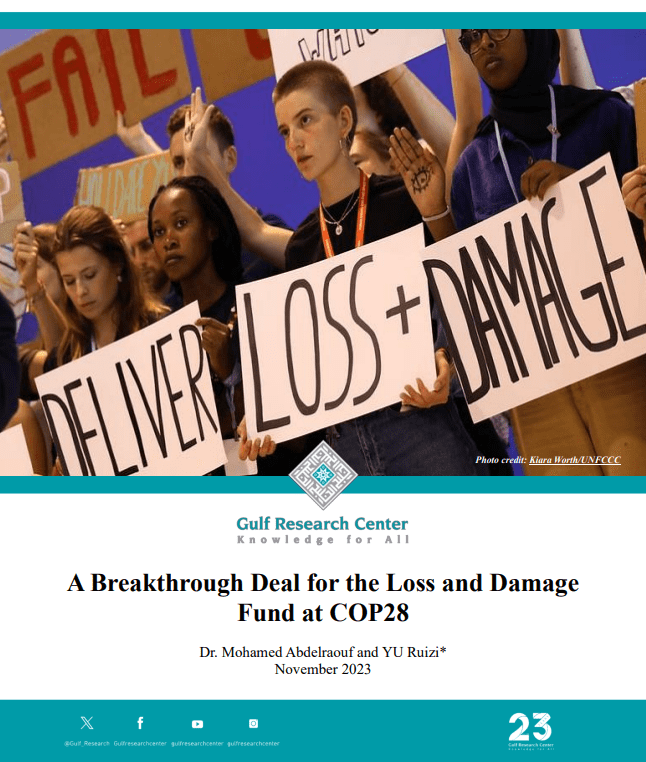
In 2022, the United Nations Climate Change Conference (COP27) reached a historic decision to establish a Loss and Damage Fund (LDF). According to the United Nations Environment Programme (UNEP), loss and damage refers to “the negative consequences that arise from the unavoidable risks of climate change, like rising sea levels, prolonged heatwaves, desertification, the acidification of the sea, and extreme events such as bushfires, species extinction, and crop failures.”1; The LDF aims to provide financial assistance for the rescue and rehabilitation of the communities that are most vulnerable to the ever-growing climate crisis.
The establishment of the LDF is the product of over three decades of intense deliberation and efforts toward climate justice for highly vulnerable developing countries. In 1991 the island state of Vanuatu called for global action to tackle loss and damage caused by climate change.2 Yet, the pace of advancing such a fund has been slow, and relevant discussions at an international level have been highly technical, limited, and unproductive.3
Article 8 of the Paris Agreement clearly outlined that “the Parties recognize the importance of averting, minimising and addressing loss and damage associated with the adverse effects of climate change” but also reiterated that it “does not involve or provide a basis for any liability or compensation.”4 At COP25 in Madrid and COP26 in Glasgow, the Group of 77 plus China (G77+China) proposed establishing a technical body and a financial facility for addressing mounting losses and damages. While the demand for technical support successfully led to the creation of the Santiago Network for Loss and Damage, the appeal for financial mechanisms remained unsettled due to opposition from high-income entities such as the EU and the USA.5 Therefore, the establishment of the LDF at COP27 not only represented a milestone in recognizing the financial needs of vulnerable developing countries in responding to the changing climate, but also marked “an important step towards justice” as was stated by Secretary-General António Guterres.6
Second, the LDF aims to close a huge gap in climate finance that has not been adequately addressed by existing funds. The Adaptation Gap Report published by UNEP in November 2022 pointed out that 160-340 billion USD by 2030 and 315-565 billion USD by 2050, is needed to close the ever-widening gap between expectations and the actual amount of the international adaptation finance that is available to developing countries.7 While marginalized and vulnerable groups, including indigenous peoples and local communities, should be prioritized in receiving climate financial assistance, existing climate financial institutions including the Green Climate Fund and the Adaptation Fund cannot effectively carry out the last-mile delivery.8 It is expected that the funding and implementation gaps will be tackled by the LDF.
With the establishment of the LDF as an official agenda item, a 24-member Transitional Committee (TC) was established at COP27 to provide guidance on how to operate the LDF, and is expected to be on the table for discussion at COP28.9 However, there are multidimensional contentions that must be addressed before implementing this revolutionary fund. First, it is challenging to achieve a consensus on the clear scope of “loss and damage” which sets the foundation for long-term cooperation. The concept of climate loss and damage is doubted by some developed countries who consider these impacts inevitable and “locked into the earth’s system,” thus unjustified for compensation.10 Furthermore, scientific assessments and enhanced knowledge are desired for understanding and agreeing on non-economic losses and damages including those to languages, cultural and historical heritages, natural capital, and ecological functions directly or indirectly resulting from extreme weather and natural disasters.
Second, there has been a great deal of contention on which institution can take charge of this fund. Some wealthy countries like the USA consider the World Bank, with its well-established infrastructure, as a promising candidate. However, other countries express objection due to its bureaucracy, high overheads, and climate finance provided as loans instead of grants. Additionally, the dominant role of wealthy countries as major donors in decision-making may hinder the LDF from delivering down-to-earth benefits to marginalized and vulnerable communities.11
Third, the list of contributor and beneficiary countries as well as the criteria of allocating compensations remain to be determined. Particularly, developed countries tend to be skeptical of emerging economies like China and oil-rich nations, such as the UAE and Saudi Arabia, as eligible funding recipients given their carbon emissions.12
The beneficiary status of countries like Singapore and the Republic of Korea in Non-Annex I Parties under the UN Framework Convention on Climate Change in 1992 is controversial considering their economic development. Reclassification may be conducted to identify countries with different levels of vulnerability to climate change. When it comes to the allocation of funds, debates are ongoing over whether the LDF should adopt a “needs-based” (e.g., the economic difficulties and vulnerability of the recipient country) criteria, a “performance-based” (e.g., the capability of making use of the money received) criteria, or a combination of both.13
Fourth, there is a lingering question mark regarding the sources of finance. The LDF is expected to deliver additionality, which refers to satisfying “the urgent and immediate need for new, additional, predictable and adequate financial resources” while not diverting priorities from existing climate-related financial mechanisms. 14To achieve this goal, new additional sources of finance are desired.
Some representatives from funding institutions suggested a diversification of funding sources that goes beyond public finance and involves philanthropic organizations and the private sector.15 The US and some developed countries are considering utilizing the proceeds from carbon offset sales.16 Additionally, innovative solutions may be developed. For instance, air travel levies and taxes might be collected voluntarily. While the global or multilateral agreements on such a collection system are not viable at an initial stage, they may be developed at the outset among “first mover” countries, then be scaled up to an EU level, and finally figure out its global pathway.17 While various ideas have been proposed for now, their political and technical feasibility and concerns for climate justice require further examination and experimentation over time.
So far, the Transitional Committee (TC) has held five meetings and two workshops since COP27, making progress on balancing different interests, and providing advice for fully putting the LFD into practice at COP28.18 During the fifth meeting on 3-4 November 2023 in Abu Dhabi, the TC reached an agreement on a list of recommendations, including a draft governing instrument that will be forwarded to COP28, despite the request of the US negotiator to weaken the financial contribution responsibilities of developed countries.19 The World Bank was proposed as a temporary host for the LDF, and an independent institution is expected at a later stage.20
Dr. Sultan Al Jaber, the COP28 President expressed gratitude to the TC for “having broken deadlocks and found common ground to deliver clear recommendations” and reaffirmed the goal to activate and capitalise the LDF at COP28.21 Whether the recommendations will be adopted or overturned depends on state negotiation outcomes and remains to be seen in Dubai. Despite all these controversial issues, let us hope that COP28 will stand a good chance at achieving a breakthrough deal related to the Loss and Damage Fund.
*Dr. Mohamed Abdelraouf is the Director of the Environmental Security and Sustainability Research Program at the Gulf Research Center, and YU Ruizi is a master’s candidate at the Geneva Graduate Institute
1 “What You Need to Know about the COP27 Loss and Damage Fund,” UNEP, November 29, 2022. https://www.unep.org/news-and-stories/story/what-you-need-know-about-cop27-loss-and-damage-fund.
2 Institute on the Environment. “Road to Dubai COP28: Any Progress on the New Loss and Damage Fund in Bonn?” Institute on the Environment, June 14, 2023. https://environment.umn.edu/news/loss-and-damage-fund-bonn/.
3 Arthur Wyns, “COP27 Establishes Loss and Damage Fund to Respond to Human Cost of Climate Change,” The Lancet Planetary Health 7, no. 1 (December 8, 2022), https://doi.org/10.1016/s2542-5196(22)00331-x.
4 “Adoption of the Paris Agreement. Proposal by the President,” UNFCCC, December 12, 2015. https://unfccc.int/documents/9064#beg
5 Dawn Pierre-Nathoniel et al., “Loss and Damage at COP25 – a Hard Fought Step in the Right Direction,” Climate Analytics, December 20, 2019, https://climateanalytics.org/comment/loss-and-damage-at-cop25-a-hard-fought-step-in-the-right-direction.
6 “COP27 Ends with Announcement of Historic Loss and Damage Fund,” UNEP, November 22, 2022. https://www.unep.org/news-and-stories/story/cop27-ends-announcement-historic-loss-and-damage-fund.
7 UNEP. “Adaptation Gap Report 2022: Too Little, Too Slow – Climate adaptation failure puts world at risk,” Nairobi. November 1, 2022. https://www.unep.org/adaptation-gap-report-2022
8 Arthur Wyns, “COP27 Establishes Loss and Damage Fund to Respond to Human Cost of Climate Change,” The Lancet Planetary Health 7, no. 1 (December 8, 2022), https://doi.org/10.1016/s2542-5196(22)00331-x.
9 “COP27 Reaches Breakthrough Agreement on New ‘Loss and Damage’ Fund for Vulnerable Countries,” UNFCCC, November 20, 2022, https://unfccc.int/news/cop27-reaches-breakthrough-agreement-on-new-loss-and-damage-fund-for-vulnerable-countries.
10 Sherine El Taraboulsi-McCarthy et al., “COP27 and the Path Ahead: Is the ‘loss and Damage’ Fund a Win for the Global South?” United Nations University, December 21, 2022, https://unu.edu/cpr/blog-post/cop27-and-path-ahead-loss-and-damage-fund-win-global-south.
11 Harvey, Fiona. “Climate crisis talk resume on ‘loss and damage’ funding for poorest countries,” The Guardian, November 3, 2023, https://www.theguardian.com/environment/2023/nov/03/un-climate-crisis-talks-resume-loss-damage-funding-poorest-countries
12 Institute on the Environment. “Road to Dubai COP28: Any Progress on the New Loss and Damage Fund in Bonn?” Institute on the Environment, June 14, 2023. https://environment.umn.edu/news/loss-and-damage-fund-bonn/.
13 Vikrant Panwar and Emily Wilkinson, “Operationalising the New ‘loss and Damage’ Fund: Six Questions,” ODI, December 8, 2022, https://odi.org/en/insights/operationalising-the-new-loss-and-damage-fund/.
14 Cameron Hill, “A Loss and Damage Fund: Two Big Challenges - World,” ReliefWeb, June 22, 2023, https://reliefweb.int/report/world/loss-and-damage-fund-two-big-challenges.
15 Lisa Schultheiß et al., “Operationalising the Loss and Damage Fund,” Germanwatch, July 13, 2023, https://www.germanwatch.org/en/88557.
16 Fiona Harvey. “Climate crisis talk resume on ‘loss and damage’ funding for poorest countries,” The Guardian, November 3, 2023, https://www.theguardian.com/environment/2023/nov/03/un-climate-crisis-talks-resume-loss-damage-funding-poorest-countries
17 Thomas Hirsch et al., “New Sources for Public Climate Finance and for the Loss and Damage Fund,” CAN Europe, October 3, 2023, https://caneurope.org/new-sources-for-public-climate-finance-loss-damage-fund/.
18 “Meetings of the Transitional Committee and Related Workshops and Events,” UNFCCC, accessed November 21, 2023, https://unfccc.int/topics/adaptation-and-resilience/groups-committees/transitional-committee/meetings-of-the-transitional-committee-and-related-workshops-and-events.
19 Julie-Anne Richard, “A Dangerous Retreat on Multilateralism: TC5 Recommendations for the Loss and Damage Fund Side-Step Climate Justice,” The Loss and Damage Collaboration, November 6, 2023, https://www.lossanddamagecollaboration.org/pages/a-dangerous-retreat-on-multilateralism-tc5-recommendations-for-the-loss-and-damage-fund-side-step-climate-justice.
20 Joe Lo, “World Bank to initially host loss and damage fund under draft deal,” Climate Home News, November 7, 2023, https://climatechangenews.com/2023/11/07/world-bank-to-initially-host-loss-and-damage-fund-under-draft-deal/
21 “COP28 Presidency Hosts Breakthrough Meeting That Agrees Recommendations on Operationalization of Loss and Damage Fund,” COP28, November 5, 2023, https://www.cop28.com/en/news/2023/11/COP28-Presidency-hosts-breakthrough-meeting-that-agrees-recommendations.

